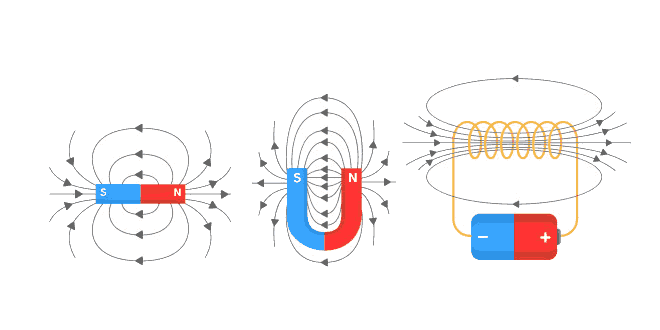Question: Given an experiment to demonstrate the force acting on current carrying conductor placed in a magnetic field.
Answer: A thick, copper wire AB is suspended vertically from a support T by means of a flexible joint J. The lower end B of this wire is free to move between the poles of a U-shaped magnet M. The lower and B of the wire just touches the surface of mercury kept in a shallow vessel V so that it can move when a force acts on it. The positive terminal of a battery is connected to end A of the wire. The circuit is completed by dipping another wire from the negative terminal of the battery into the mercury in vessel as shown in the figure. We know that mercury is a liquid which is a good conductor of electricity, so the circuit is completed. On pressing the switch, a current flows in the wire AB in the vertically downward direction. The wire AB is kicked in forward direction (towards south) and its lower end B reaches the position B’, so that the wire comes to the new position AB’ as shown by the dotted line in the figure. When the lower end B of the hanging wire comes forwards to B’, its contact which the circuit breaks and current stops flowing in the wire Ab.
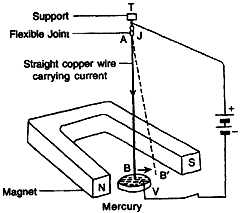
Since no current flows in the wire, no force acts on the wire in this position and it falls back to its original position. As soon as the wire falls back, its lower end again touches the mercury surface, current starts flowing in the wire and it is kicked again. This reaction is repeated as long as the current is passed in wire AB. It may be noted that the current carrying wire is kicked forward because a force is exerted on it by the magnetic field of the U -shaped magnet. From this experiment, we conclude that when a current carrying conductor is placed in a magnetic field, a mechanical force is exerted on the conductor which makes it move.
Question: What is the function of an earth wire? Why is it necessary to earth metallic appliances?
Answer: The function of the earth wire is to ensure the safe passage of the excessive current into the ground. If due to some reason such as short circuiting, an excessive current flows through the earth the live wire, it will pass to the earth through the earth wire if there is earthing, otherwise, it may cause a fire due to overheating of the live wire.
When the live wire of a faulty appliance comes is contact with the metallic casing of the appliance due to break of insulation, the whole appliance acquires the same potential as that of the live wire. If a person touches such an appliance, he gets a fatal shock. But if the appliance is earthed, the heavy current flowing through is blows the fuse in the circuit. This saves the person touching the appliance and also the appliance.
Question: Explain what is short circuiting and overloading in an electric supply.
Answer: Short circuiting is the connection between two points in a circuit across which the resistance is very low. As a result, most of the current bypasses part of the circuit and flows between these two points. Short circuiting occurs when the live wire comes in direct contact with the neutral wire such that a zero resistance path is provided to the current. The current then does not pass through the appliance, but a heavy current passes through the wires of the circuit.
Overloading: Every circuit is designed to carry a pre-determined amount of power. When the power in the circuit exceeds the pre-determined value then the circuit is said to be overloaded.
Question: Explain with the help of a figure the ring system of wiring in domestic wiring.
Answer: The ring system is as shown in the figure below:
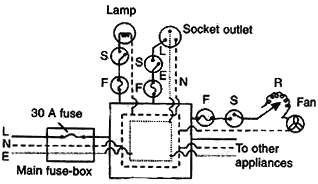
It consists of a ring-circuit. Wires starting from the main fuse-box run round all the main rooms of the house and then come black to the fuse-box again. The fuse-box contains a fuse of rating about 30 A. A separate connection is taken from the live wire of the ring for each appliance. The terminal of the appliance is connected to the live wire through a separate fuse and a switch. If the fuse of one appliances. For each appliance, the wires used for connection should be of proper current carrying capacity.
Question: What are the safety measures to be taken while dealing with household electricity?
Answer: It goes beyond doubt that electricity plays a very important role in our lives. It is one of the most important and convenient source of energy at homes and industries. However, we daily come across reports regarding hazards of electricity. Use of electricity can prove to be very dangerous if certain precautions and safety measures are not observed in the design of electrical devices and in handling them. The various safety measures to be taken are:
- Use wires of high quality, proper amperage and good insulating material.
- Cover all naked wires and joints with insulating tape.
- All connections at plugs, switches, sockets must be tight.
- Replace any defective plugs switches and sockets.
- Never touch any parts of the circuit without putting on rubber shoes or rubber gloves.
- Use fuse (nowadays MCB) of proper rating and material.
- All electrical appliances must be properly earthed.
- Connect switches and fuse to live wires.
- Put out the main switch in case of short circuiting and fire.
- Do not use water as fire extinguishers in case of fire due to electricity.
Question: (1) What are magnetic field lines? How is the direction of a magnetic field at a point determined?
(2) Draw to field lines around a bar magnet along its length on it two sides and mark the field directions on them by arrow marks.
(3) List any three properties of magnetic field lines.
Answer:
- Magnetic field lines are the pictorial representation of a magnetic field. The direction of magnetic field at a point is determined by using a magnetic needle. The direction of the magnetic field at that point.
- Two field lines around a bar magnet are shown in figure.
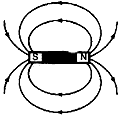
- Properties of magnetic field lines are:
(i) They travel from the north to the south pole of a magnet outside the magnet and from south to the north pole inside the magnet.
(ii) They are continuous closed curves.
(iii) They emerge out normally from the magnetised surfaces.
Question: (a) Draw a schematic labelled diagram of a domestic wiring circuit which includes (i) a main fuse (ii) a power meter (iii) one light point and (iv) a power plug.
(b) Why is it necessary to connect an earth wire to electric appliances having metallic covers?
Answer: (a) The schematic diagram is as shown below:

(b) It is necessary to connect an earth wire to electrical appliances having metallic covers to protect us from the harmful effects of electric shock, as the earth wire at the time of any leakage of current or any other defect carries the current to the earth.
Question: Why is pure iron not used for making permanent magnets? Name one used for making permanent magnets. Describe how permanent magnets are made electrically. State two examples of electrical instruments made by using permanent magnets.
Answer: Pure iron easily gets demagnetised, therefore, it is not used to make permanent magnets.
Alnico an alloy of iron, nickel, cobalt and aluminium is used for making permanent magnets.
An Alnico rod is placed inside a solenoid and a large current is passed through it for a long time. This converts the Alnico piece into a permanent magnet.
Two examples of electrical instruments are electric motor and electric bell.
Question: (a) What is an electromagnet? What does it consist of?
(b) Name one material in each case which is used to make a: (i) permanent magnet (ii) temporary magnet.
(c) Describe an activity to show how you can make an electromagnet in your school laboratory.
Answer: (a) An electromagnet is an appliance which produces a magnetic field around its conductor coil on passing electric current through its coil.
It consists of a core of iron metal or its alloy and a solenoid conductor coil around the core.
(b) (i) Alnico alloy is used for making permanent magnets.
(ii) Soft iron metal is used for making temporary magnet.
(c) Take about 10 iron nails of equal length and wrap an insulated copper wire around them in the form of a solenoid coil. Now, connect this appliance to a battery and key switch this appliance to a battery and key switch as shown in the diagram. When the current is passed through the coil, the nails inside the coil act as a core and get magnetised. Such an arrangement is called an electromagnet.
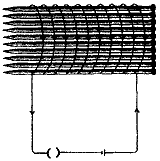
Question: (a) What is meant by a ‘magnetic field’?
(b) How is the direction of magnetic field at a point determined?
(c) Describe an activity to demonstrate the direction of the magnetic field generated around a current carrying conductor.
(d) What is the direction of magnetic filed at the centre of a current carrying circular loop?
Answer: (a) It is the region around a magnet where its magnetic force can be felt.
(b) It is determined by using a magnetic compass. It can also be determined by using the right hand thumb rule.
(c) Take a piece of cardboard. Insert a wire to pass through its centre, normal to the plane of the cardboard is fixed and does move up and down. Now, sprinkle some iron filings on the cardboard and pass the current through the wire. You would find that the iron filings align themselves showing a pattern of concentric circles
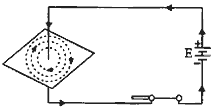
around the wire (see fig.). These concentric circles on the cardboard represent the field lines. The arrows shows on the circle indicate the direction of the north pole of the compass needle when placed there and hence, of the magnetic field produced due to a current carrying wire. If the direction of the electric current is reversed, the deflection of the needle would also reverse, and so would the direction of the magnetic field lines.
(d) It is in the form of a straight line.
Question: (1) What is the function of an earth wire in electrical instruments? Why is it necessary to earth the metallic electric appliances?
(2) Explain what is short-circuiting and overloading in a electric supply.
(3) What is the usual capacity of the fuse wire in the line to feed:
(i) light and fans?
(ii) appliances of 2 kW or more power?
Answer:
- It ensure that any leakage of current in the electrical instrument flows to the earth without causing any harm to the user. It is necessary to earth the metallic electrical device so as to safe the user from electric shock.
- Short-circuiting: When a live wire comes in direct contact with a neutral wire, a large current begins to flow in the circuit. This is called short-circuiting.
Overloading: It is a structure in which too many device are connected to the same point in a circuit. - (i) Lights and fans -5 A.
(ii) Appliances of 2 kW or more -15 A.
Question: Describe in short an activity to:
(i) demonstrate the pattern of magnetic field lines around a straight current carrying conductor, and
(ii) find the direction of magnetic field produced for a given direction of current in the conductor. Name and state the rule to find the direction of magnetic field associated with a current carrying conductor. Apply this rule to determine the direction of the magnetic field inside and outside a current carrying circular loop lying horizontally on a table. Assume that the current through the loop is anticlockwise.
Answer: (i) Take a battery (12 V), a variable resistance (or a rheostat), an ammeter (o-5 A), a plug, key and a long straight thick copper wire. Insert the thick wire through the centre, normal to the plane of a rectangular cardboard. Take care that the cardboard is fixed and does not slide up or down. Connect the copper wire vertically between the points X and Y, as shown in figure, in series with the battery, a plug and key. Sprinkle some iron filings uniformly on the cardboard. (You may use a salt sprinkler for this purpose.) Keep the variable of the rheostat at a fixed position and note the current through the ammeter. Close the key so that a current flows through the wire. Ensure that the copper wire placed between the points X and Y remains vertically straight. Gently tap the cardboard a few times. Observe the pattern of the iron filings. You would find that the iron filings align themselves showing a pattern of concentric circles around the copper wire.
(ii) When a magnetic compass is placed on these, lines it too experienced a force in the direction of a magnetic field. Thus, the direction of the needle of the compass gives the direction of the magnetic field. Now, when the current is magnetic field. Now, When the current is reversed, the direction of deflection of the needle also reverses. This shows that the direction of a magnetic field has also reversed.
The rule is the right hand thumb rule. It states that “Grasp the conductor in the right hand with the thumb pointing in the direction of current, and then the direction n which the fingers curl gives the direction of the magnetic field.”
Consider the current loop as shown:

Inside the loop, the magnetic field is upwards and outside the loop, it is downwards.
 Class Notes NCERT Solutions for CBSE Students
Class Notes NCERT Solutions for CBSE Students
